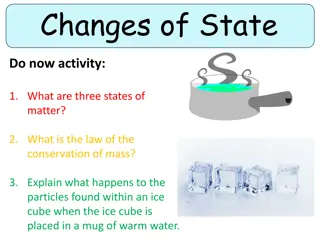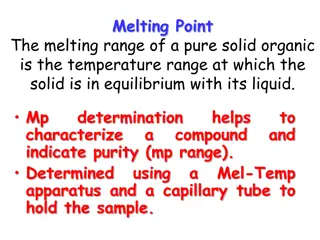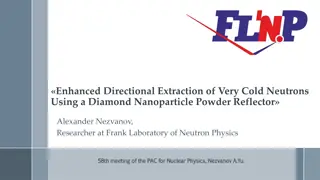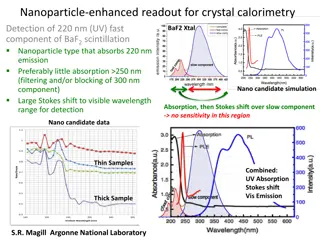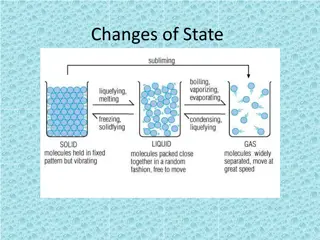
Unveiling Nanoparticle Melting Phenomena
Intriguing world of nanoparticle melting phenomena and its implications in various applications. Delve into the significance of melting point depression, different measurement techniques, and the impact of surface-to-volume ratios on nanoparticle behavior. Understand the relationship between cohesive energy, atomic bonds, and melting temperatures of nanoparticles.
Download Presentation

Please find below an Image/Link to download the presentation.
The content on the website is provided AS IS for your information and personal use only. It may not be sold, licensed, or shared on other websites without obtaining consent from the author. If you encounter any issues during the download, it is possible that the publisher has removed the file from their server.
You are allowed to download the files provided on this website for personal or commercial use, subject to the condition that they are used lawfully. All files are the property of their respective owners.
The content on the website is provided AS IS for your information and personal use only. It may not be sold, licensed, or shared on other websites without obtaining consent from the author.
E N D
Presentation Transcript
Nanotechnology 1 25/10/2016
Melting point depression is a very important issue for applications involving nanoparticles. Nanoparticles are currently used or proposed for prominent roles in catalyst, sensor, medicinal, optical, magnetic, thermal, electronic, and alternative energy applications. Nanoparticles must be in the solid state to function at elevated temperatures in several of these applications. Two techniques allow measurement of the melting point of nanoparticle. The first one is by electron beam of the transmission electron microscope (TEM) which can be used to melt nanoparticles.The melting temperature is estimated from the beam intensity, while changes in the diffraction conditions to indicate phase transition from solid to liquid. This method allows direct viewing of nanoparticles as they melt, making it possible to test and characterize samples with a wider distribution of particle sizes. 2 25/10/2016
The second one is by developed nanocalorimeters that directly measure the enthalpy and nanoparticles.Nanocalorimeters provide the same data as bulk calorimeters, however additional calculations must account for the presence of the substrate supporting the particles. Nanoparticles have a much greater surface to volume ratio than bulk materials. The increased surface to volume ratio means surface atoms have a much greater effect on chemical and physical properties of a nanoparticle. Surface atoms bind in the solid phase with less cohesive energy because they have fewer neighboring atoms in close proximity compared to atoms in the bulk of the solid. melting temperature of 3 25/10/2016
Each chemical bond an atom shares with a neighboring atom provides cohesive energy, so atoms with fewer bonds and neighboring atoms have lower cohesive energy. The average cohesive energy per atom of a nanoparticle has been theoretically calculated as a function of particle size according to Equation (1). .......................................................................... (1) Where: D=nanoparticle size d=atomic size Eb=cohesive energy of bulk As Equation (1) shows, the effective cohesive energy of a nanoparticle approaches that of the bulk material as the material extends beyond atomic size range (D>>d). 4 25/10/2016
Atoms located at or near the surface of the nanoparticle have reduced cohesive energy due to a reduced number of cohesive bonds. The cohesive energy of an atom is directly related to the thermal energy required to free the atom from the solid. According to Lindemann s temperature of a material is proportional to its cohesive energy, av(TM=Cav).Since atoms near the surface have fewer bonds and reduced cohesive energy, they require less energy to free from the solid phase. Melting point depression of high surface to volume ratio materials results from this effect. For the same reason, surfaces of bulk materials can melt at lower temperatures than the bulk material. criterion, the melting 5 25/10/2016
The theoretical size-dependent melting point of a material can be calculated through classical thermodynamic analysis. The result is the Gibbs Thomson equation shown in Equation (2). ............................................................. (2) Where: TMB=Bulk Melting temperature sl=solid liquid interface energy Hf=Bulk heat of fusion s=density of solid d=particle diameter 6 25/10/2016
On the other hand, there is another important factor; it is the shape of nanoparticles. Nanoparticle shape impacts the melting point of a nanoparticle. Facets, edges and deviations from a perfect sphere all change the magnitude of melting point depression. These shape changes affect the surface to volume ratio, which affects the cohesive energy and thermal properties of a nanostructure. Equation (3) gives a general shape corrected formula for the theoretical melting point of a nanoparticle based on its size and shape. . . (3) Where: c=materials constant z=shape parameter of particle The shape parameter is (1) for sphere and (3/2) for a very long wire, indicating that melting-point depression is suppressed in nanowires compared to nanoparticles. 7 25/10/2016
Electrical Properties:- The properties like conductivity or resistivity are come under category of electrical properties. These properties are observed to change at nanoscale level like optical properties. The examples of the change in electrical properties in nanomaterials are: Conductivity of a bulk or large material does not depend upon dimensions like diameter or area of cross section and twist in the conducting wire etc. However it is found that in case of carbon nanotubes conductivity changes with change in area of cross section. It is also observed that conductivity also changes when some shear force (in simple terms twist) is given to nanotube. 3) Conductivity of a multiwalled carbon nanotube is different than that of single nanotube of same dimensions. 4) The carbon nanotubes can act as conductor or semiconductor in behaviour but we all know that large carbon (graphite) is good conductor of electricity. 8 25/10/2016
In electrically conducting carbon nanotubes, only one electron wave mode is observed which transport the electrical current. As the lengths and orientations of the carbon nanotubes are different, they touch the surface of the mercury at different times, which provides two sets of information: (i) The influence of carbon nanotube length on the resistance; and (ii) The resistances of the different nanotubes. As the nanotubes have different lengths, then with increasing protrusion of the fiber bundle an increasing number of carbon nanotubes will touch the surface of the mercury droplet and contribute to the electrical current transport. 9 25/10/2016
Figure (2) Electrical behavior of naotubes 10 25/10/2016
There are three categories of materials based on their electrical properties: (a) conductors; (b) semiconductors; and (c) insulators. The energy separation between the valence band and the conduction band is called Eg (band gap). The ability to fill the conduction band with electrons and the energy of the band gap determine whether a material is a conductor, a semiconductor or an insulator. 11 25/10/2016
In conducting materials like metals, the valence band and the conducting band overlap, so the value of (Eg) is small: thermal energy is enough to stimulate electrons to move to the conduction band. In semiconductors, the band gap is a few electron volts. If an applied voltage exceeds the band gap energy, electrons jump from the valence band to the conduction band, thereby forming electron-hole pairs called excitons. Insulators have large bandgaps that require an enormous amount of voltage to overcome the threshold. This is why these materials do not conduct electricity (Figure 3). 12 25/10/2016
Figure 3: Schematic illustration of the valence and conduction bands in materials based on their electrical properties: insulator, semiconductor and conductor 13 25/10/2016
Quantum confinement and its effect on material electrical properties:- Quantum confinement causes the energy of the band gap to increase as illustrated in Figure 4. Furthermore, at very small dimensions when the energy levels are quantified, the band overlap present in metals disappears and is actually transformed into a band gap. This explains why some metals become semiconductors as their size is decreased 14 25/10/2016
Figure 4: The image compares the energy of the band gap (arrow) in a bulk semiconductor, a quantum dot and an atom. As more energy states are lost due to the shrinking size, the energy band gap increases. 15 25/10/2016



